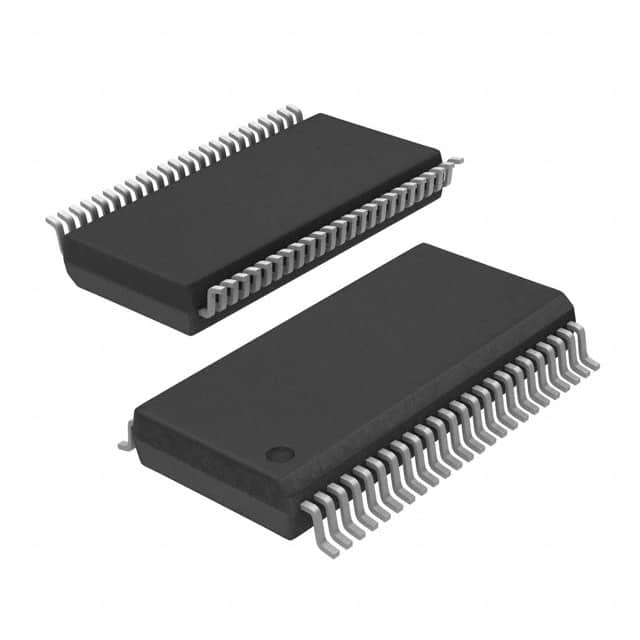Lihat spesifikasi untuk detail produk.

SN74LVC16245ADLRG4
Product Overview
- Category: Integrated Circuit (IC)
- Use: Level Shifter and Bus Transceiver
- Characteristics: Bi-directional voltage level translation between different logic levels, high-speed operation, low power consumption
- Package: 48-pin TSSOP (Thin Shrink Small Outline Package)
- Essence: The SN74LVC16245ADLRG4 is a 16-bit bus transceiver with 3-state outputs. It is designed to provide bidirectional voltage level shifting between 3.3V and 5V logic levels.
- Packaging/Quantity: Available in reels of 2500 units
Specifications
- Supply Voltage Range: 1.65V to 5.5V
- Logic Voltage Levels: 3.3V and 5V
- Maximum Data Rate: 100 Mbps
- Number of Channels: 16
- Output Drive Capability: ±24 mA
- Operating Temperature Range: -40°C to +85°C
Detailed Pin Configuration
The SN74LVC16245ADLRG4 has a total of 48 pins, which are divided into four groups:
- Group A (Pins 1-12): Port A Inputs/Outputs
- Group B (Pins 13-24): Port B Inputs/Outputs
- Group C (Pins 25-36): Control Inputs
- Group D (Pins 37-48): Power Supply and Ground Pins
For the detailed pin configuration diagram, please refer to the datasheet provided by the manufacturer.
Functional Features
- Bidirectional Voltage Level Translation: Allows seamless communication between devices operating at different logic levels.
- 3-State Outputs: Enables multiple devices to share a common bus without interfering with each other.
- High-Speed Operation: Supports data rates up to 100 Mbps, making it suitable for applications requiring fast data transfer.
- Low Power Consumption: Designed to minimize power consumption, making it ideal for battery-powered devices.
Advantages and Disadvantages
Advantages: - Bi-directional level shifting capability simplifies interfacing between different logic levels. - 3-state outputs allow multiple devices to share a common bus, reducing the number of required pins. - High-speed operation enables efficient data transfer in time-critical applications. - Low power consumption extends battery life in portable devices.
Disadvantages: - Limited voltage translation range (3.3V to 5V) may not be suitable for all applications requiring level shifting. - The package size (48-pin TSSOP) may require careful PCB layout design to ensure proper heat dissipation.
Working Principles
The SN74LVC16245ADLRG4 uses a combination of MOSFETs and CMOS technology to achieve bidirectional voltage level translation. It employs a direction control signal to determine the direction of data flow between the A and B ports. When the direction control signal is set to one logic level, data flows from Port A to Port B, and vice versa when the control signal is set to the opposite logic level.
Detailed Application Field Plans
The SN74LVC16245ADLRG4 can be used in various applications that require voltage level translation, such as:
- Interfacing between microcontrollers operating at different logic levels.
- Communication between devices with different voltage requirements, such as sensors and microcontrollers.
- Bus communication in mixed-voltage systems, where different components operate at different logic levels.
Detailed and Complete Alternative Models
- TXB0108PWR: 8-bit Bidirectional Voltage-Level Translator
- PCA9306DCTR: Dual Bidirectional I2C-Bus and SMBus Voltage-Level Translator
- SN74AVC4T245PWR: 4-bit Dual-Supply Bus Transceiver with Configurable Voltage Translation
These alternative models offer similar functionality and can be considered as alternatives to the SN74LVC16245ADLRG4 based on specific application requirements.
Note: The content provided above is a general overview of the SN74LVC16245ADLRG4. For more detailed information, please refer to the datasheet provided by the manufacturer.
Sebutkan 10 pertanyaan dan jawaban umum terkait penerapan SN74LVC16245ADLRG4 dalam solusi teknis
Sure! Here are 10 common questions and answers related to the application of SN74LVC16245ADLRG4 in technical solutions:
Q: What is SN74LVC16245ADLRG4? A: SN74LVC16245ADLRG4 is a 16-bit bus transceiver with 3-state outputs, designed for voltage level translation between different logic levels.
Q: What is the operating voltage range of SN74LVC16245ADLRG4? A: SN74LVC16245ADLRG4 operates within a voltage range of 1.65V to 5.5V.
Q: Can SN74LVC16245ADLRG4 be used for bidirectional communication? A: Yes, SN74LVC16245ADLRG4 supports bidirectional data flow, making it suitable for applications requiring both input and output data transmission.
Q: What is the maximum data transfer rate supported by SN74LVC16245ADLRG4? A: SN74LVC16245ADLRG4 can support data transfer rates up to 100 Mbps.
Q: How many channels does SN74LVC16245ADLRG4 have? A: SN74LVC16245ADLRG4 has 16 bidirectional channels, allowing for parallel data transmission.
Q: Can SN74LVC16245ADLRG4 handle level shifting between different voltage domains? A: Yes, SN74LVC16245ADLRG4 is specifically designed for voltage level translation, making it suitable for interfacing between different voltage domains.
Q: Does SN74LVC16245ADLRG4 have built-in ESD protection? A: Yes, SN74LVC16245ADLRG4 has built-in ESD protection, ensuring robustness against electrostatic discharge.
Q: What is the power supply current consumption of SN74LVC16245ADLRG4? A: The power supply current consumption of SN74LVC16245ADLRG4 varies depending on the operating conditions and data transfer rates. Please refer to the datasheet for detailed information.
Q: Can SN74LVC16245ADLRG4 be used in automotive applications? A: Yes, SN74LVC16245ADLRG4 is qualified for automotive applications and meets the necessary standards and requirements.
Q: Are there any recommended layout guidelines for using SN74LVC16245ADLRG4? A: Yes, Texas Instruments provides layout guidelines in the datasheet to ensure proper performance and minimize signal integrity issues. It is recommended to follow these guidelines during PCB design.
Please note that these answers are general and may vary based on specific application requirements. Always refer to the official datasheet and consult with the manufacturer for accurate and up-to-date information.

